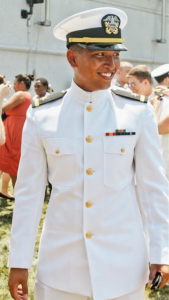 Age: 25
Hometown: Lucban, Quezon, Philippines
Current residence: Pensacola, Florida
United States Naval Academy, 2012
Information Technology major
Age: 25
Hometown: Lucban, Quezon, Philippines
Current residence: Pensacola, Florida
United States Naval Academy, 2012
Information Technology major
Meet Ivin Dysancgo, a naval flight officer in the US Navy. He is currently completing training in Pensacola – this involves acquiring flight hours in various types of aircraft and learning navigation, emergency procedure and other technological support for pilots. A typical workday may start as early as 3:00AM, and usually lasts for twelve hours. Despite the high levels of stress associated with his job, he enjoys it.
“It’s amazing being in the air. If I see something [interesting] from the air, I try to drive there later to see what it looks like on the ground,” Dysangco explains with some laughter. He hopes to work with special forces or the Coast Guard upon completing training.
Involvement in the Fil-Am community After attending the Naval Academy Preparatory School (NAPS) in Newport, Rhode Island, he went to the Naval Academy, where he studied IT, engineering, navigation, leadership, and military law. Aside from academics, Dysangco and his friends sought out a Filipino community to get involved with. While at NAPS, they learned about the Filipino Intercollegiate Networking Dialogue (FIND) and decided to drive a total of 16 hours over a weekend to attend the conference in Maryland. While there, they networked with UniPro and other Fil-Am leaders.
“Once we got to the Academy, we looked for a Filipino group. But, it wasn’t as active as we wanted to be. So, we restarted the club,” Dysanco explains.
Dysangco and his friends wanted the freshmen to get involved early, so they could network and become leaders for the organization. So, they’d send them as delegates to attend FIND and other related events. In order to get the community involved, they invited the Filipina aunties that worked in the galley to their meetings. The midshipmen (a term for ‘students’ at the Academy) shared the things they missed from home, including Filipino food. Soon, the aunties were bringing Filipino dishes to their events.
“We’d go in the back kitchen and there would be a lot of Filipinos and food there,” Dysangco adds proudly. The revamped organization now welcomes all members from the community, not just students. They have a Naval Officer representative as a member, who invites midshipmen over for home-cooked meals. They’ve hosted guest speakers, including one of the highest-ranking Filipino-American officers, to talk about life as a Fil-Am in the Navy.
A passion for photography
In addition to getting involved with the Fil-Am community at the Academy, he also developed a love for photography.
Shortly after a visit to the White House with his sponsor family, which resulted in poorly photographed photos as keepsakes, Dysangco decided he wanted to be able to take nice photos. So, he invested in a better quality camera and began taking photos of buildings. He then reached out to the USNA Public Affairs Office at the Academy, and was taken under the chief officer’s wing. He has photographed important meetings and events with government officials, including the Secretaries of Defense and the Navy, admirals and generals.
“If you’re in public affairs, you get full access to anything. So, it made it easier to talk to those big people,” Dysangco notes. His photography career has since expanded to fashion and portrait photography.
“When you’re taking photos, you get to meet interesting people and travel,” Dysangco adds. He’s thankful for his passion for photography, because it has allowed him to network with many people to discuss their mistakes and advice. One influential individual, the former Commandant of the Naval Academy, offered him some quite memorable advice.
“He told me, ‘respect everyone that you meet, because you don’t know where they’ve been or where they came from,’” Dysangco reflects. He admires the Commandant for his approachability and understanding of students, despite having a high rank in comparison to midshipmen attending the academy.
Advice for fellow Fil-Ams and Pilipinos Dysangco is glad he has found a way to fit his interests into his career in the Navy. He notes that with photography, he’s been able to travel and see things that people don’t typically get to see. He views his job as a naval flight officer as a form of photography too, as he gets to travel and see spectacular views from the air; he especially loves flying during sunset. From all of his experiences thus far, he offers the following advice to other emerging leaders.
“Whatever you do, don’t think about the money. Choose a job that you enjoy. Try to find something [where] every time you go, it doesn’t feel like a job. If you have a passion for it, then your passion is going to take care of you.”
Photo credit: Oreo Ortega

